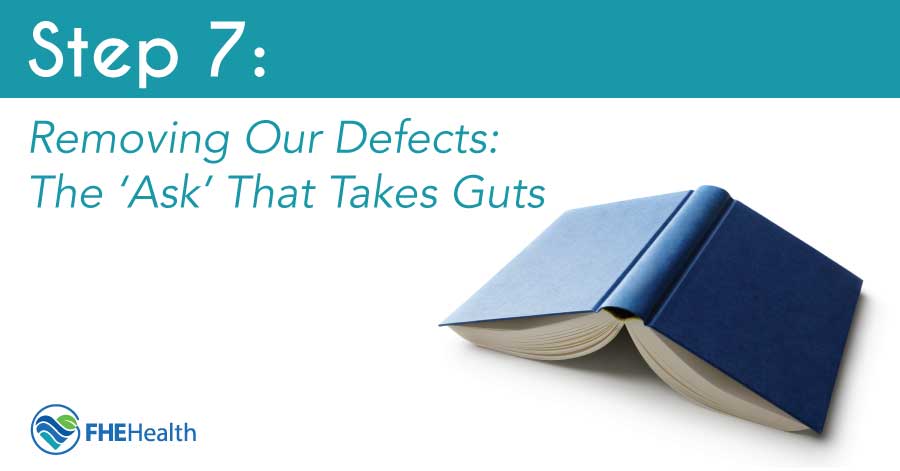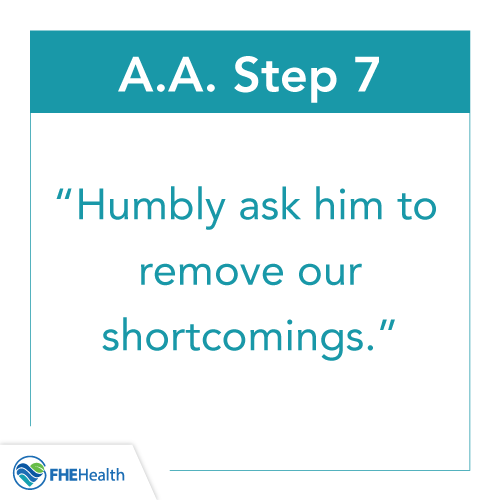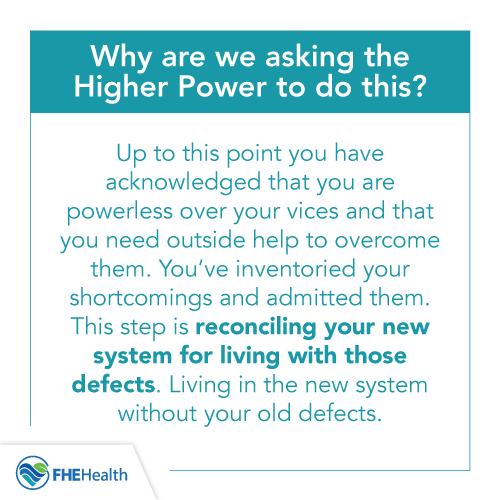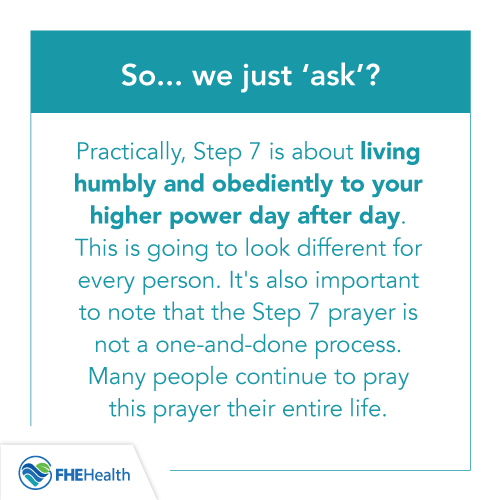
Step 7 of AA is about committing to a new way of living. It doesn’t mean changing fundamentally who you are: you have a personality, spirit, and history that is uniquely you, and getting sober doesn’t change that. In fact, working through the 12 steps and seeking a drug- or alcohol-free lifestyle helps you live a life that is healthier and truer to your real self — the person you were meant to be. And step 7 is a critical stepping stone on that journey.
12 Steps: Step 7 Explained
 Step 7 as published states, “Humbly ask him to remove our shortcomings.”
Step 7 as published states, “Humbly ask him to remove our shortcomings.”
To understand this step, you first have to consider it within the context of the six steps that came before. Prior to this point in the AA journey, someone would have:
- Admitted their powerlessness over alcohol (or drugs, in the case of NA)
- Engaged in the belief that a higher power (something outside of self, since self is powerless against alcohol) could restore them to sanity
- Made an active decision to turn their life over to this power
- Completed a moral inventory (or a list of wrongs)
- Admitted, to the higher power and another person, the nature of those failings
- Sought a place of readiness to have the higher power remove those failings or defects
Now, in step 7, it’s time to take action from that place of readiness. And the action is to ask the higher power to remove the defects.
Why ask the higher power?
 One of the reasons it’s important to consider step 7 of AA in context is because the truths of the previous steps help make this one make more sense. Without steps 1 through 6, you may be left wondering:
One of the reasons it’s important to consider step 7 of AA in context is because the truths of the previous steps help make this one make more sense. Without steps 1 through 6, you may be left wondering:
- Whether a higher power can remove defects
- Why you need to have defects removed to begin with
- Why you would ask a higher power to do this work instead of just doing it yourself
All of these questions are answered in the previous steps. Step 2 has us come to terms with the fact that we are not a reliable operator of ourselves. There is something more powerful than us and this higher power can restore us to sanity. This power that is outside of you has the ability to work with, through and on you to help you break the insanity of the cycle of addiction, and if it can do that, surely it can help you choose to turn away from wrongdoings and “defects.”
Steps 4 and 5 involve creating an inventory of your defects and admitting those to yourself, your higher power and at least one other human. The natural result of these steps is usually to realize that you want to change these issues, which is the reason you would seek to remove the defects.
Step 1 — the very first of the journey — indicates that you are powerless against your addiction when you face it alone. The same can be true of many other issues. We are not always able to face them down alone, which is why we ask a power outside of ourselves for assistance.
How do you ask humbly?
Step 7 starts with how you ask, which is ‘humbly’. Alcoholics Anonymous says that humility is a foundational principle for all 12 steps. Every step also helps you get to a place where you can humbly ask your higher power to work in your life. By this time, you’ve admitted your powerlessness over alcohol and spent time looking at your wrongdoings and potential moral failings, and these are very humbling steps to take.
Step 7 AA: Committing to a New Way of Living
Ultimately, Step 7 is about committing to a new way of approaching and living your life. You’ve inventoried all the things you believe are wrong with your way of living, and this is the point where you turn the page — with help from your higher power.
How Are Our Defects Removed?
 Let’s be honest: This is not a magic process or step. Yes, prayer is an incredibly powerful thing. And a higher power working in your life can bring extreme change in ways you might never expect. But it still takes work from you.
Let’s be honest: This is not a magic process or step. Yes, prayer is an incredibly powerful thing. And a higher power working in your life can bring extreme change in ways you might never expect. But it still takes work from you.
Our defects are removed when we continue to turn our lives — every day, every minute — over to that higher power. They are removed when we continue to work toward a better future, making more positive choices until those choices become habits.
In short: our defects are removed slowly. And they are, in this lifetime, never fully gone. We are only able to withstand them because of the strength a higher power brings into our lives.
A Practical Look at Step 7
Practically, Step 7 is about living humbly and obediently to your higher power day after day. This is going to look different for every person. It’s also important to note that the Step 7 prayer is not a one-and-done process. Many people continue to pray this prayer their entire life. Look at Step 7 not as an ask you make of the higher power that is just so you can move on. Instead, Step 7 is learning about how to make this ask so that you can do it correctly for the rest of your life.
Step 7 AA Checklist
The Step 7 Prayer
You can find Step 7 AA prayers online for a variety of faiths, or you can pray your own version of this prayer. Simply follow the outline below to ensure you cover all the points of Step 7.
- Begin with a humble mindset and heart.
- Acknowledge the role your higher power has in your life.
- Ask the higher power to remove what stands between you and the life that power would have you live.
- Ask for strength as you continue on the 12-step path.
- Ask for self-control in remaining turned away from the defects and toward your higher power.
Get Support for Your 12-Step Journey
It’s not just you and your higher power against the world. Humans are creatures of fellowship; we were created to support each other. If you’re ready to start the 12-Step journey or you simply want to talk to someone about seeking help with your addiction, contact us at FHE today.
Our 12-Step Series:
- Why the 12-step Program Still Works
- Step 1: Why the 12-step Journey Begins with Powerlessness
- Step 2: What is a Higher Power?
- Step 3: God as you Understand Him
- Step 4: Your Moral Inventory
- Step 5: Admitting Your Wrongs
- Step 6: Addressing Character Defects
- Step 7: Removing our Defects
- Step 8
- Step 9: Making Amends, How to Approach Step 9
- Step 10: Ongoing Inventory
- Step 11
- Step 12
- Understanding AA Lingo






